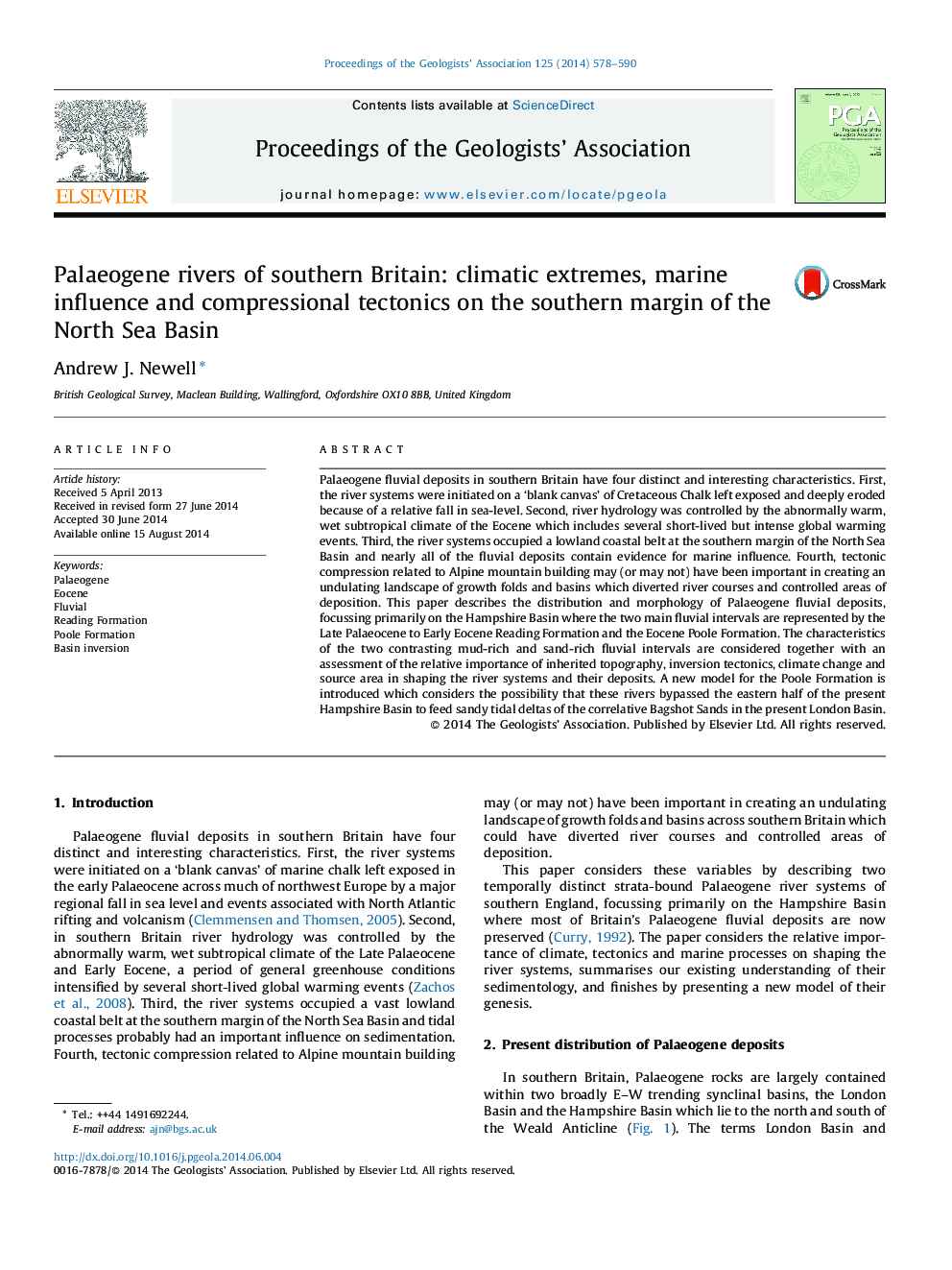| کد مقاله | کد نشریه | سال انتشار | مقاله انگلیسی | نسخه تمام متن |
|---|---|---|---|---|
| 4735002 | 1640651 | 2014 | 13 صفحه PDF | دانلود رایگان |
عنوان انگلیسی مقاله ISI
Palaeogene rivers of southern Britain: climatic extremes, marine influence and compressional tectonics on the southern margin of the North Sea Basin
ترجمه فارسی عنوان
رودخانه های پالئوژن جنوبی بریتانیا: افراطی آب و هوایی، نفوذ دریایی و سازه های فشرده در حاشیه جنوبی حوضه دریای شمال
دانلود مقاله + سفارش ترجمه
دانلود مقاله ISI انگلیسی
رایگان برای ایرانیان
ترجمه چکیده
رسوبات فلوئالیس پائولین در جنوب بریتانیا دارای چهار ویژگی مشخص و جالب است. اول، سیستم های رودخانه ای بر روی یک بوم خالی از گچ کرتاسه که به علت کاهش نسبی سطح دریا در معرض عمق فرسایش قرار گرفته اند، آغاز شده است. دوم، هیدرولوژی رودخانه توسط آب و هوای غیرطبیعی گرم و مرطوب جو زمین از ائوسن تحت کنترل قرار گرفت که شامل چندین رویداد خفیف، اما شدید گرم شدن کره زمین است. سوم، سیستم های رودخانه، کمربند کمربندی ساحلی در حاشیه جنوبی حوضه دریای شمال را اشغال کردند و تقریبا تمام رسوب های رشته ای حاوی شواهدی برای نفوذ دریایی است. چهارم، فشردگی تکتونیکی مربوط به ساختمان کوه آلپ ممکن است (یا شاید نباشد) در ایجاد یک چشم انداز کوهستانی از چشمه های رشد و حوضه ها مهم است که مسیرهای رودخانه و مناطق تحت کنترل رسوب را کنترل می کند. این مقاله توزیع و مورفولوژی رسوبات فلوئال پائئون را توصیف می کند و در درجه اول بر حوضه های همپشیر تمرکز می کند که دو فواصل اصلی فلوئالی توسط پالئوسن پسین به سازند خواندن اولیه ائوسن و سازند ائوسن پوول نشان داده شده است. ویژگی های دو فواصل فلوی با غنای غنای گلی و غنی با غنای متقابل همراه با ارزیابی اهمیت نسبی توپوگرافی ارثی، تکتونیک های معکوس، تغییرات آب و هوا و ناحیه منبع در شکل دهی سیستم های رودخانه و رسوبات آنها مورد توجه قرار گرفته است. مدل جدیدی برای سازند پویل معرفی شده است که احتمالا این رودخانه ها را از نیمی از شرق حوضه های همپشیر عبور می کند تا دلتای شنی شبیه سگ های بگشوت در حوضه لندن کنونی را از بین ببرد.
موضوعات مرتبط
مهندسی و علوم پایه
علوم زمین و سیارات
زمین شناسی
چکیده انگلیسی
Palaeogene fluvial deposits in southern Britain have four distinct and interesting characteristics. First, the river systems were initiated on a 'blank canvas' of Cretaceous Chalk left exposed and deeply eroded because of a relative fall in sea-level. Second, river hydrology was controlled by the abnormally warm, wet subtropical climate of the Eocene which includes several short-lived but intense global warming events. Third, the river systems occupied a lowland coastal belt at the southern margin of the North Sea Basin and nearly all of the fluvial deposits contain evidence for marine influence. Fourth, tectonic compression related to Alpine mountain building may (or may not) have been important in creating an undulating landscape of growth folds and basins which diverted river courses and controlled areas of deposition. This paper describes the distribution and morphology of Palaeogene fluvial deposits, focussing primarily on the Hampshire Basin where the two main fluvial intervals are represented by the Late Palaeocene to Early Eocene Reading Formation and the Eocene Poole Formation. The characteristics of the two contrasting mud-rich and sand-rich fluvial intervals are considered together with an assessment of the relative importance of inherited topography, inversion tectonics, climate change and source area in shaping the river systems and their deposits. A new model for the Poole Formation is introduced which considers the possibility that these rivers bypassed the eastern half of the present Hampshire Basin to feed sandy tidal deltas of the correlative Bagshot Sands in the present London Basin.
ناشر
Database: Elsevier - ScienceDirect (ساینس دایرکت)
Journal: Proceedings of the Geologists' Association - Volume 125, Issues 5â6, December 2014, Pages 578-590
Journal: Proceedings of the Geologists' Association - Volume 125, Issues 5â6, December 2014, Pages 578-590
نویسندگان
Andrew J. Newell,
